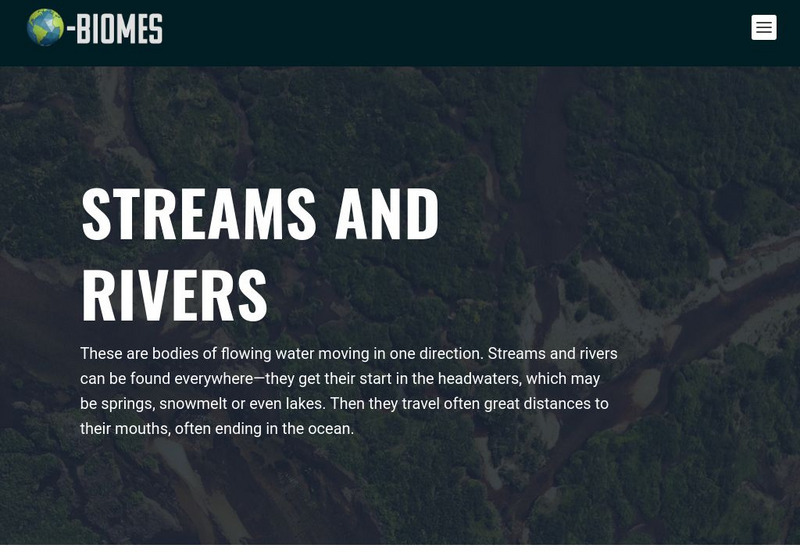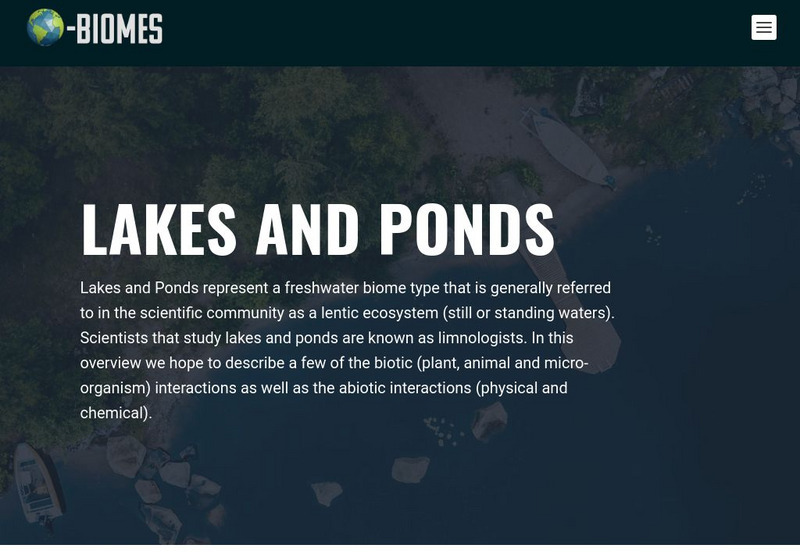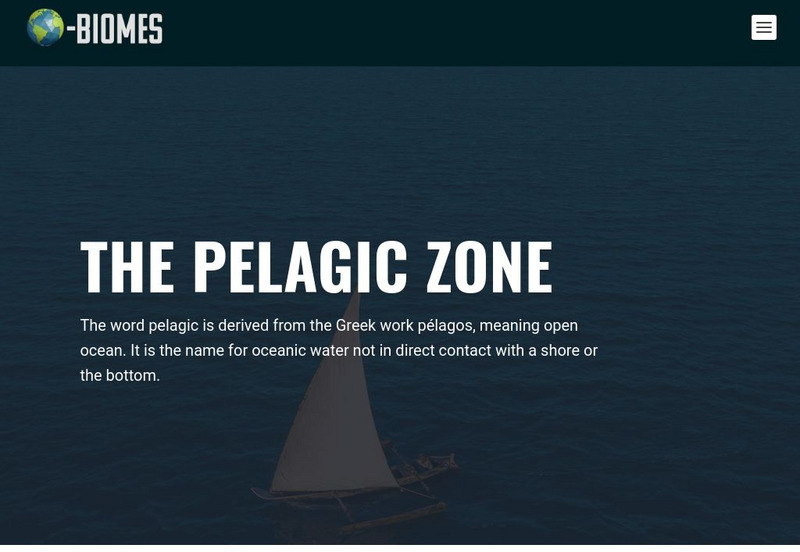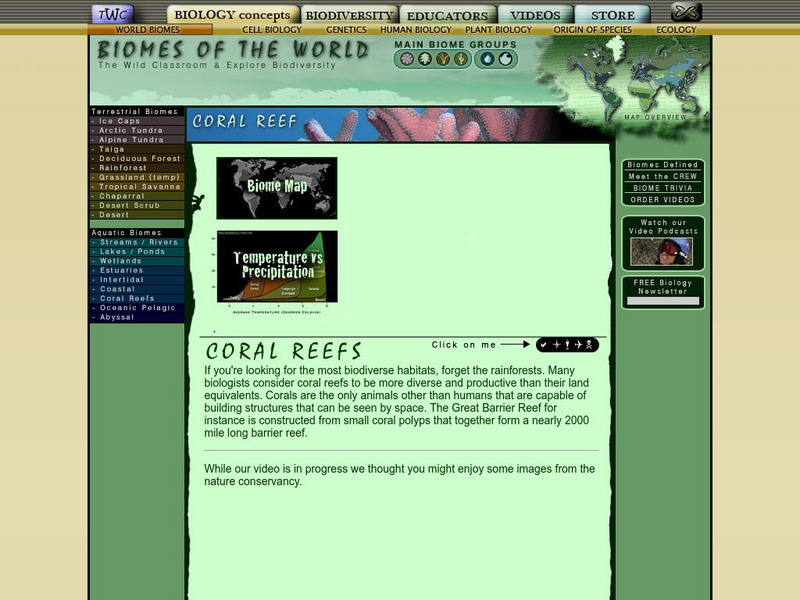The Wild Classroom
The Wild Classroom: Biomes of the World: Polar Ice Caps Biome
Learn about the polar ice cap ecosystem. Find out about plants, animals, adaptations, and conservation efforts.
The Wild Classroom
The Wild Classroom: Biomes of the World: Desert Scrub Biome
Learn about the desert scrub ecosystem. Find out about plants, animals, adaptations, and conservation efforts.
The Wild Classroom
The Wild Classroom: Biomes of the World: Streams and Rivers
Learn about stream and river ecosystems. Find out about plants, animals, adaptations, and conservation efforts.
The Wild Classroom
The Wild Classroom: Biomes of the World: Lakes and Ponds
Learn about lake and pond ecosystems. Find out about plants, animals, adaptations, and conservation efforts.
The Wild Classroom
The Wild Classroom: Biomes of the World: Wetlands Biome
Learn about wetlands ecosystems. Find out about plants, animals, adaptations, and conservation efforts.
The Wild Classroom
The Wild Classroom: Biomes of the World: Coastal Ocean Biome
Learn about the coastal ecosystem. Find out about plants, animals, adaptations, and conservation efforts.
The Wild Classroom
The Wild Classroom: Biomes of the World: Oceanic Pelagic Biome
Learn about the oceanic pelagic ecosystem. Find out about plants, animals, adaptations, and conservation efforts.
PBS
Pbs Learning Media: Wild Kratts: All About Lizards Lesson Plan
Students explore the diversity of lizards in terms of characteristics, behavior, and habitat. Activities feature five species of lizards and their special body structures needed for survival.
University of California
Ucmp: The World's Biomes
The University of California Museum of Paleontology hosts this site devoted to the study of the earth's biomes, which are the world's major communities, classified according to the predominant vegetation and adaptations of organisms to...
Other
Elk Facts
Read some quick facts about elk from the Rocky Mountain Foundation. Including where they come from, what they eat, and how they have adapted. You can also print out an elk maze to test your knowledge.
US Navy
Office of Naval Research: Green Sea Turtle
This very thorough site examines the physical characteristics, adaptations and current research associated with the Green Sea Turtle. A quick quiz is also a part of this site.
Lincoln Park Zoo
Lincoln Park Zoo: Amur or Siberian Tiger
This site provides detailed information on the Siberian Tiger. Information includes what they look like, where they live, what they eat, and how many cubs they have. Additional information about special adaptations they have.
Lincoln Park Zoo
Lincoln Park Zoo: Baringo Giraffe
This site about the Baringo Giraffe, provides information ranging from a detailed description to special adaptations that the giraffe has developed. A good site for student research.
Lincoln Park Zoo
Lincoln Park Zoo: Dwarf Crocodile
Offers great information of the West African Dwarf Crocodile. Information includes what they look like, where they are found, what they eat, and how often they reproduce. Special adaptations that the crocodile has made are also included.
Other
Dr. Seward's Gila Monster Web Site: Gila Monsters
In addition to covering morphology, range, unique adaptations, activity patterns food & metabolism, and intraspecific interactions, this this site examines several interesting superstitions and fables related to the gila monster.
Sea World Parks & Entertainment
Sea World: Bottlenose Dolphins
Outlines the characteristics of the bottlenose dolphin, including classification, habitat, behaviors, and conservation.
PBS
Pbs Learning Media: Teri and Jairus: Biome Buddies
This video segment from ZOOM compares and contrasts the habitat and life forms found in Death Valley with those found in the temperate rain forest of the Pacific Northwest. [3:46]
The Wild Classroom
The Wild Classroom: Biomes of the World: Coral Reef Biome
Learn about the coral reef ecosystem. Find out about plants, animals, adaptations, and conservation efforts.
Scholastic
Scholastic: Science Explorations: Animals, Adaptations and the Galapagos Islands
Discover the effects human impact has had on the native organisms of the Galapagos Islands.
BBC
Bbc Schools: Ks2 Bitesize: Science: Living Things: Plant and Animal Habitats
Place the aliens in the habitats where they can survive the best. Following the activity, read more about plant and animal habitats, and then take a quick quiz to check for understanding.
PBS
Nh Pbs: Nature Works: Polar Bears
This site created by NatureWorks focuses on the Polar Bears. The content of this resource includes a look at this species' characteristics, range, habitat, diet, behavior and life cycle.
Michigan State University
Michigan State University: Lets Net: Dinosaurs and Us Unit
The focus of this lesson unit is on adaptation - how dinosaurs adapted to their habitat in order to survive. Students will explore online dinosaur exhibits and record information they find. This leads to a discussion of adaptation and...
Enchanted Learning
Enchanted Learning: Polar Bears
Learn more about the polar bear when you visit this informative site that features a diagram of the polar bear and information on its diet, habitat, anatomy, reproduction and so on.
Curated OER
National Park Service: Arches National Park: Plants
Information about the cacti, grasses, lichens, trees, shrubs, and wildflowers that grow in Arches National Park, located in Moab, Utah. Focus is placed on the adaptations of these plants that allow survival in a desert habitat.
Other popular searches
- Animal Habitats Adaptation
- Animal Adaptation Habitat
- Penguins Adaptation Habitat
- Penguin Adaptation Habitat
- Bird Habitat and Adaptation
- Habitat and Adaptation




















